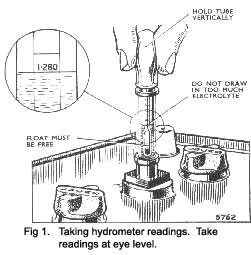
The specific gravities and their indications are as follows:
Climate ordinarily below 80°F. (26.7oC.)
Cell fully charged I•270—1•290
Cell half charged I•19O—1•210
Cell fully discharged 1•110—1•130
Climate ordinarily above 80°F. (26 .7°C.)
Cell fully charged I•210—I•230
Cell half charged I•300 --1•150
Cell fully discharged I•050—1•070
The specific gravity of the electrolyte varies with its temperature. The figures quoted above are for an electrolyte temperature of 60°F. (15.6°C.). If the electrolyte temperature Is above 60°F. (15.6°C.) add 0•002 to the hydrometer reading for each 5°F. (2.8°C.) rise to obtain true specific gravity. Similarly 0•002 must be deducted from the hydrometer reading for each 5°F. (2 •8°C.) below 60°F. (15•6°C.).
The temperature must be that actually Indicated by a thermometer immersed in the electrolyte and not the surrounding atmospheric temperature.
If the level of the electrolyte Is so low that a hydro-meter reading cannot be taken, no attempt should be made to take a reading after adding distilled water until the battery has been on charge for at least thirty minutes. NEVER transfer electrolyte from one cell to -another.
|
Note—If the car is out of use for any length of time the battery should not be allowed to run down or to remain in a discharged condition, it should be recharged about every fortnight from an independent electric supply.
Heavy discharge test
A heavy discharge tester consists of a centre-zero volt-meter, 2 or 3 volts full scale, across which is connected a shunt resistance capable of carrying the current involved.
The current or loading element for testing car type batteries is one that will limit the current yielded by a good cell to 150—160 amperes. Before testing, each cell must be at least 70% charged, having a minimum electrolyte density of 1 .250 s.g. (shade temperatures normally below 80°F. (26.7°C.)) or 1•180 s.g. in hotter climates. It will be observed that there are five small indentations on the battery lid; these coincide with the concealed inter-cell connectors beneath. The indentations must be pierced with a pointed tool. Pointed prongs are provided for making contact with the internal cell connectors. Press the contact prongs against the exposed terminals of each cell. A good cell will maintain a constant reading of 1 2 to 1•5 volts for ten seconds. A faulty cell will show a rapidly falling voltage. Re-seal the holes with sealing compound after testing. Remember that if the battery is subjected to heavy loads (I.e., long periods of night parking with lights on) without suitable opportunities for recharging, a low state of charge is only to be expected. A fault in the generator or regulator, or neglect during a period out of commission, may also be responsible for any trouble.
RECHARGING FROM AN EXTERNAL SUPPLY
If tests indicate that the battery is discharged, but is otherwise in good condition, it should be re-charged, either on the vehicle by a period of daytime running or on the bench from an external supply. If the latter, the battery should be charged until the specific gravity and voltage show no increase over three successive hourly readings. During the charge the electrolyte must be kept level with the top of the separator guard by the addition of distilled water. The re-charge rate is as follows
BVZ 11A Batteries (67 ampere-hour) 6 amps.
Do not allow the temperature of the electrolyte to exceed
|
 **
**
